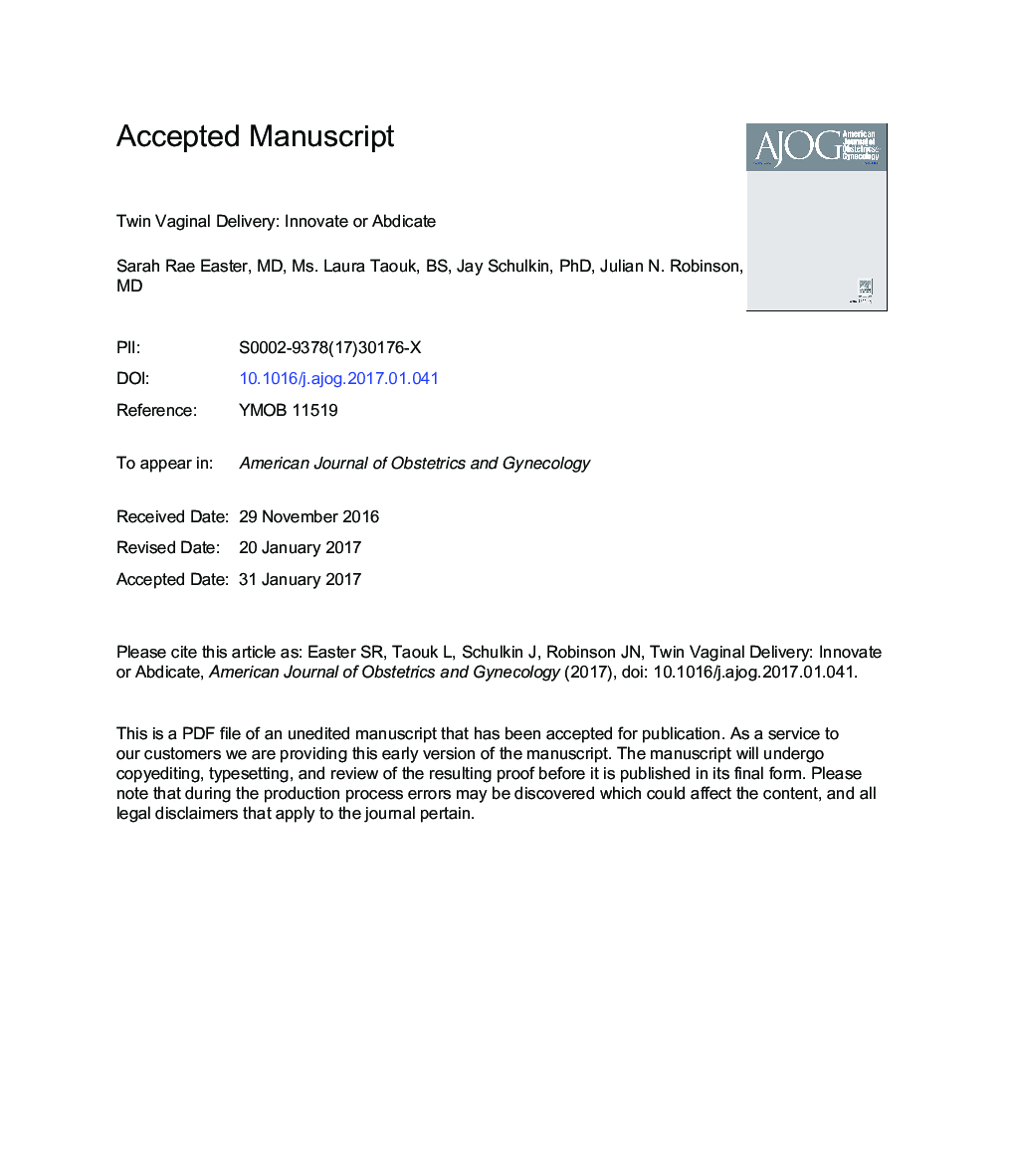| کد مقاله | کد نشریه | سال انتشار | مقاله انگلیسی | نسخه تمام متن |
|---|---|---|---|---|
| 5675668 | 1594876 | 2017 | 25 صفحه PDF | دانلود رایگان |
عنوان انگلیسی مقاله ISI
Twin vaginal delivery: innovate or abdicate
ترجمه فارسی عنوان
تحویل واژن دوقلو: نوآوری یا رد کردن
دانلود مقاله + سفارش ترجمه
دانلود مقاله ISI انگلیسی
رایگان برای ایرانیان
کلمات کلیدی
استخراج دهانه رحم، زنان باردار آموزش ارائه دهندگان، شبیه سازی، دوقلوها، زایمان واژن،
موضوعات مرتبط
علوم پزشکی و سلامت
پزشکی و دندانپزشکی
پزشکی و دندانپزشکی (عمومی)
چکیده انگلیسی
Neonatal safety data along with national guidelines have prompted renewed interest in vaginal delivery of twins, particularly in the case of the noncephalic second twin. Yet, the rising rate of twin cesarean deliveries, coupled with the national decline in operative obstetrics, raises concerns about the availability of providers who are skilled in twin vaginal birth. Providers are key stakeholders for increasing rates of twin vaginal delivery. We surveyed a group of practicing obstetricians to explore potential barriers to the vaginal birth of twins with a focus on delivery of the noncephalic second twin. Among 107 responding providers, only 57% would deliver a noncephalic second twin by breech extraction. Providers who preferred breech extraction had a higher rate of maternal-fetal medicine subspecialty training (26.2% vs 4.3%; P<.01) and were more likely to be in an academic practice environment (36.1% vs 10.9%; P<.01) and to practice in high-volume centers that deliver >30 sets of twins annually (57.4% vs 34.8%; P=.02). Most providers (54.2%) were familiar with the findings from the recent randomized trial that demonstrated the safety of twin vaginal birth. However, knowledge of the trial was not associated statistically with a preference for breech extraction (62.3% vs 43.5%; P=.05). Providers who preferred breech extraction were more likely to agree with recent society guidelines that encourage the vaginal birth of twins (86.9% vs 63.0%; P<.01). In an adjusted analysis, the 46% of providers with a perceived need for more training were far less likely to prefer breech extraction for delivery of a noncephalic second twin (adjusted odds ratio, 0.38; 95% confidence interval, 0.16-0.95). Furthermore, 57% of providers who would not offer their patient breech extraction would be willing to consult a colleague for support with a noncephalic twin delivery. These results suggest that scientific evidence and society opinion are likely insufficient to reverse the national trends that favor cesarean delivery for twins. Instead, implementation of provider training and support programs is critical for increasing the rates of twin vaginal birth. Changing our national landscape of vaginal twin delivery may require innovation. Without novel provider-focused strategies, we may relinquish passively the requisite skills for not only our patients but also for future generations of obstetricians.
ناشر
Database: Elsevier - ScienceDirect (ساینس دایرکت)
Journal: American Journal of Obstetrics and Gynecology - Volume 216, Issue 5, May 2017, Pages 484-488.e4
Journal: American Journal of Obstetrics and Gynecology - Volume 216, Issue 5, May 2017, Pages 484-488.e4
نویسندگان
Sarah Rae MD, Ms. BS, Jay PhD, Julian N. MD,
